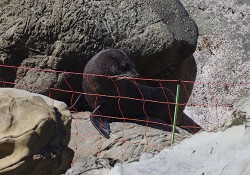The NZ Transport Agency is teaming up with the Department of Conservation (DOC) to ensure that the native fur seal breeding colony at Ohau Point is protected while work is undertaken to clear slips and restore the coastal Kaikoura road and rail corridor.

Transport Agency Earthquake Recovery Manager Steve Mutton says the Agency and its partners in the North Canterbury Transport Infrastructure Recovery alliance are firmly committed to protecting the unique coastal marine area and mitigating any impacts on wildlife as rebuild work progresses.
“The slips brought down by the November earthquake at Ohau Point are massive, and the task of clearing them is huge. Ohau Point is also home to the largest fur seal breeding colony on the east coast of the South Island. It is an ecologically and culturally significant site, and the importance of protecting the unique coastal marine environment is a key factor as we develop our plans for the restoration of this section of the transport corridor.”
Mr Mutton says in addition to working closely with DOC, the Transport Agency has also engaged an independent marine scientist to help develop a strategy to manage the seal habitat and protect seals during construction activity.
The first phase of the strategy involves a two week trial, now underway at slip site 7, a 20,000m3 slip north of Ohau Point. The trial is using ‘seal-proof fencing’ and on site seal herding to keep adults and pups away from the immediate base of the slip site, clear of falling rocks and debris while helicopter sluicing and slip clearance work is carried out.
DOC Regional Manager Roy Grose says early observations of the trial have shown encouraging results.
“After some small adjustments, the fencing is working well to keep the seals out of harm’s way. Inspections have shown no seals on the landward side near the slip base, which is a successful result.”
Mr Grose says at the end of the trial, the results will be reviewed by DOC, the Transport Agency and an iwi cultural monitor, and the information will be used to help develop methods to protect seals for the full period of construction.
“This is challenging work, and we may need to come up with some creative solutions in the weeks and months ahead. Everyone working on this project is committed to doing the job the right way, and that means recognising the importance of protecting our coastal marine life while undertaking this vital work for the people of Kaikoura.”
Mr Grose says the seal population along this stretch of coastline remains healthy. There are estimated to be more than 1,500 seal pups between Halfmoon Bay and Paparoa Point, about half of which are north of Ohau Stream.
Mr Mutton says crews are continuing working with helicopters and monsoon buckets to clear the slips north of Kaikoura of loose material to allow safe access for work crews and heavy machinery.
“These slips are still highly unstable, hazardous sites, with large rocks and other loose material frequently falling. It’s important that the slips are stable and loose material is removed before we move our people and machinery into place below them.
“We know that people are anxious to see progress on the ground, and we’re working hard to re-open SH1 and the railway line as quickly as possible to re-connect communities and help get the region back on its feet.”